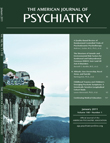Revision of the Personality Disorder Model for DSM-5
To the Editor: The DSM-5 Personality and Personality Disorder Work Group welcomes input from research and clinical communities, as represented by the commentary by Jonathan Shedler, Ph.D. et al. (1), published in the September 2010 issue of the Journal. Addressing many of the authors' concerns, the work group has significantly changed its originally proposed new model of personality and personality disorder assessment and diagnosis, in response to comments posted on the American Psychiatric Association DSM-5 website.
The model is now considerably simpler. It consists of the following three dimensional components: a rating of levels of personality functioning, ratings of personality types, and independent ratings of personality trait domains and facets (i.e., disassociated from the types pending further research, as suggested by Shedler et al.). These three components are combined to yield criterion A (mild or greater impairment in personality functioning) and criterion B (either a good or very good match to a type or an extreme rating on one of the six trait domains) of the revised general criteria for a personality disorder. The model is flexible and focuses attention on personality psychopathology with increasing degrees of specificity, depending on a clinician's available time, information, and expertise. Thus, the level rating helps a clinician to determine whether or not a patient has a personality-related problem and, if so, how severe it is. The type rating allows for the characterization of personality problems according to broad descriptions. The trait ratings enable further description of the heterogeneity of any type by a patient-specific trait profile, if desired, and also describe patients who do not have a good match to any of the proposed types (“personality disorder trait-specified,” formerly known as personality disorder not otherwise specified).
The rationales for the proposed changes are documented in literature reviews and have been summarized in forthcoming articles (e.g., 2). Serious problems with the current personality disorder diagnostic system are thoroughly documented in the literature. Thus, more than incremental change appears to be justified, just as serious problems with reliability justified precedent-setting changes from DSMII to DSM-III. Although good scientific rationales exist for proposing the inclusion of five particular types related to current DSM-IV-TR personality disorder criteria, prototypes are now being considered for all 10 personality disorders, to ease the transition to DSM-5. The proposed trait structure model was derived carefully from existing trait models (e.g., Five Factor Model; Schedule for Nonadaptive and Adaptive Personality; Dimensional Assessment of Personality Pathology, etc.) to broadly cover pathological personality traits. The validity of the trait model is being assessed in a multi-wave community survey.
The simplified and streamlined proposal will be tested in field trials for reliability and clinical utility. We anticipate further changes based on these results. We also look forward to continuing our dialogue with experts in the research and treatment of personality disorders, as well as with the clinical community, as DSM-5 progresses.
1. : Personality disorders in DSM-5. Am J Psychiatry 2010; 167:1026–1028Link, Google Scholar
2. : Personality disorder types proposed for DSM-5. J Personal Disord (in press)Google Scholar



